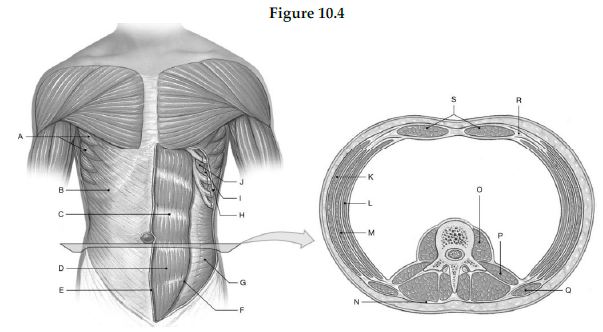Using the figure below, identify the labeled part.

1) Label A: ______________________________
2) Label B: ______________________________
3) Label C: ______________________________
4) Label D: ______________________________
5) Label E: ______________________________
6) Label F: ______________________________
7) Label G: ______________________________
8) Label H: ______________________________
9) Label I: ______________________________
10) Label J: ______________________________
11) Label K: ______________________________
12) Label L: ______________________________
13) Label M: ______________________________
14) Label N: ______________________________
15) Label O: ______________________________
16) Label P: ______________________________
17) Label Q: ______________________________
18) Label R: ______________________________
19) Label S: ______________________________
1) Serratus anterior
2) External oblique
3) Tendinous inscription
4) Rectus abdominis
5) Linea alba
6) Cut edge of rectus sheath
7) Internal oblique
8) External oblique (cut
9) External intercostal
10) Internal intercostal
11) External oblique
12) Transversus abdominis
13) Internal oblique
14) Thoracolumbar fascia
15) Psoas major
16) Quadratus lumborum
17) Latissimus dorsi
18) Rectus sheath
19) Rectus abdominis
You might also like to view...
The ____________________ vertebra is the vertebra prominens.
Fill in the blank(s) with the appropriate word(s).
Blocklike masses that form from paraxial mesoderm and develop into muscle, axial skeleton, cartilage, and dermis are known as __________
Fill in the blank with correct word.
What is a base?
A. A molecule that releases hydrogen atoms when added to water B. A molecule with a pH less than 7 C. A molecule that releases hydroxide ions when added to water D. A molecule with a pH of 7
The secretion of prolactin is controlled by ________.
A. action potentials from the hypothalamus B. a releasing hormone and an inhibiting hormone from hypothalamus C. a releasing hormone from hypothalamus D. the concentration of water in body fluids